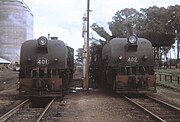South Australian Railways 400 class
| South Australian Railways 400 class Beyer-Garratt articulated locomotive | |||||||||||||||||||||||||||||||||||||||||
|---|---|---|---|---|---|---|---|---|---|---|---|---|---|---|---|---|---|---|---|---|---|---|---|---|---|---|---|---|---|---|---|---|---|---|---|---|---|---|---|---|---|
 Preserved Beyer-Garratt loco 409 at the National Railway Museum, Port Adelaide | |||||||||||||||||||||||||||||||||||||||||
| |||||||||||||||||||||||||||||||||||||||||
| |||||||||||||||||||||||||||||||||||||||||
| |||||||||||||||||||||||||||||||||||||||||
| |||||||||||||||||||||||||||||||||||||||||
The South Australian Railways 400 class comprised ten 4-8-2+2-8-4 articulated steam locomotives built in France in 1952 and 1953 under licence to Beyer, Peacock & Co. Ltd, Manchester, UK. The locomotives mainly hauled ore on the 1067 mm (3 ft 6 in) narrow-gauge line from the New South Wales/South Australia border to smelters at Port Pirie until 1963, when they were replaced by diesel locomotives. They also operated on the line to the break-of-gauge station at Terowie. Some locomotives were returned to service in 1969 while narrow gauge diesel locomotives were converted to 4 ft 8+1⁄2 in (1,435 mm) standard gauge. Subsequently some were stored at Peterborough before being scrapped.[1]
Two have been preserved, in static condition:
- No. 402 at the Zig Zag Railway, Lithgow[2]
- No. 409 at the National Railway Museum, Port Adelaide.[3]
Gallery[edit]
-
General arrangement of the 400 class Beyer-Garratt (click to enlarge)
-
Preserved Garratt 409 at the National Railway Museum, Port Adelaide
-
In 1968, Garratts 402 (leading) and 401 ready to depart Jamestown for Peterborough and the New South Wales border
-
Garratts 402 and 401 at Jamestown in the late 1960s
Notes[edit]
References[edit]
- ^ "3801 A Legend in Steam". YouTube. 15 July 2015.
- ^ "Steam locomotives". Zig Zag Railway. Zig Zag Railway Co-op Ltd. 2019. Retrieved 29 December 2019.
- ^ "Locomotive 409". National Railway Museum, Port Adelaide.
Select bibliography[edit]
- Durrant, A.E. (1987), Garratt locomotives of the world, Bracken Books, ISBN 1-85170-141-9
- Smith, J.D.H. (2009). "South Australian Railways steam locomotives".
- Oberg, Leon (2007), Locomotives of Australia: 1850s–2007, Rosenberg Publishing, pp. 271–272, ISBN 978-1877058547
External links[edit]
 Media related to South Australian Railways 400 class locomotives at Wikimedia Commons
Media related to South Australian Railways 400 class locomotives at Wikimedia Commons- Locomotive Specifications at SteamLocomotive.com





